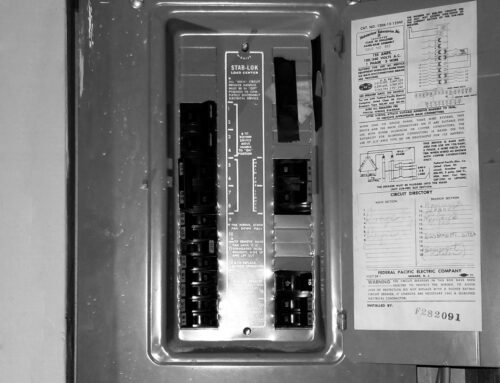Electrical panels are the main distribution for the power in your home. Every home has one which has either fuses or different breakers to control all the different circuits in your home. If yours is older than 30 years, it’s likely you should replace your electrical panel.
In newer homes, panels are typically found inside near the front outer wall of your garage with the meter enclosure on the back side outside. Older homes can sometimes have panels located in bedrooms, living rooms, or sometimes in non-compliant and dangerous places such as bathrooms or clothes closets. Electrical panels are energized from the electrical meter in the meter enclosure. The electrical panel along with the meter enclosure makes up an electrical service.
Breakers or fuses found inside your electrical panel control different circuits in your home. Fuses stopped being used in the main electrical panel in the late 1950’s so they’ll only be found in older homes. All homes since then have been using circuit breakers in panels. The purpose of Overcurrent Protection Devices (OCPD), such as breakers, is to deliver power, but more importantly to turn it off in case of an issue.

So when should you replace your electrical panel?
When it’s old and dangerous
Panels aren’t made to last forever and need to be replaced after a certain period of time. Breakers can mechanically break so they are unable to be reset or can connect poorly to the bus supplying power. Over time the enclosure of the panel or certain parts of the electrical connections can corrode or become brittle due to moisture, excessive heat, or loose connections. When issues like these are found it is usually very important to have an electrician come in. They’ll be able to confirm if you need your panel replaced immediately as it could become a fire hazard. Furthermore, if your existing panel is older than a few decades, it’s likely in need of being replaced soon.
When there are unreliable breakers
Most panels will only accept the same brand breaker to be installed in them. Older panels such as Federal Pacific Electric (FPE) and Zinsco are no longer made. Breakers for these panels usually cost upwards of $100+ for each breaker to replace. These breakers tend to be unreliable and may not trip as soon as they should. These panels should be replaced with full space panels as they’re past their end of life.
When you need more power
Some older panels have less spaces allowed for circuits or sometimes are capable of delivering less power. We utilize many more things electrically than we did 20+ years ago that typically require their own circuits. Very old electrical services, typically with a circular meter enclosure about the size of an electrical meter, were good for up to 60A of power. After that, the next big upgrade was to a 125A service with a larger meter enclosure usually in the shape of a square slightly bigger than the circular 60A enclosures. Nowadays, we have the modern 200A services with enclosures of a much larger rectangle to accommodate the larger wires needed. These are what are installed in most new construction homes to this day.
In summary, you should replace your electrical panel if:
- Corrosion, warped plastic, burnt or broken pieces are discovered in your panel.
- Breakers do not function properly or are difficult to turn on/off.
- Panel was installed before 1980 (40 years ago) and you’re in need of additional electrical spaces.
- Split-bus panel exists / no main breaker present and you want to install additional larger power drawing appliances or install a manual transfer switch for a generator.
The electrical service and panel should be replaced by a licensed, insured, and bonded electrical company like us. Since it is the main distribution point for your power, it is important to make sure it is done safely and to code. Our electricians will be able to properly install everything so there’s no safety hazards. Additionally, we coordinate with each local power company to schedule the disconnection of power to replace your electrical panel safely.



